It started with a tweet on July 8, 2024, when Ola founder and CEO Bhavish Aggarwal announced the launch of Ola Maps for developers. The CEO also officially announced that Ola Cabs was moving away from Google Maps, the company’s mapping partner until then.
Incidentally, this came on the heels of Aggarwal’s tussle with Microsoft-owned LinkedIn and the company migrating away from Microsoft’s cloud solution Azure. So the move from Google to Ola Maps naturally attracted a lot of attention on social media.
Since then, Ola Maps has been in the news for various reasons.
For one, Aggarwal claimed that Google Maps reduced prices for certain core APIs by up to 70% in response to the Ola Maps launch.
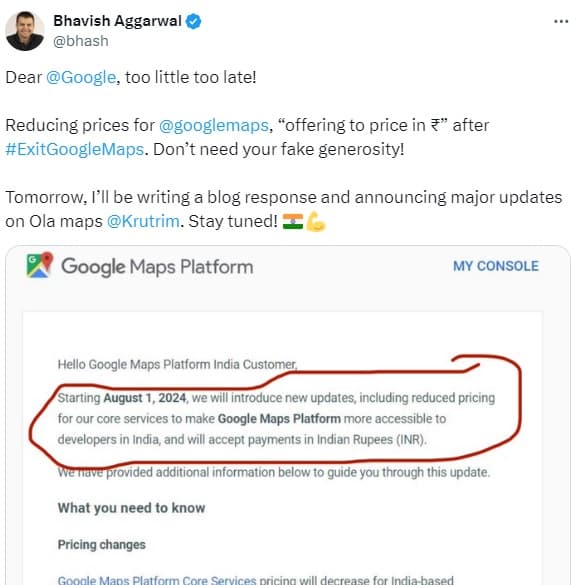

But Developers that use the Google Maps API told Inc42 that Google had already announced a price reduction a few months before Aggarwal tweeted about Ola Maps. “We knew about it for at least a month before the announcement. Google, being a big company, likely planned it further in advance,” said the founder of a route planning and optimisation startup.
Then, Ola was hit by a legal notice from listed mapping major MapmyIndia for alleged data theft and reverse engineering Ola Maps by duplicating MapmyIndia APIs. Soon after, Aggarwal dismissed this notice as being opportunistic.
But out of nowhere, India’s mapping services space has become a hotbed of competition, controversy and allegations. Ola and Aggarwal are at the centre of this frenzy, and the CEO is supremely confident that Ola Maps will be the next big thing from the house of Ola.
Sources told Inc42 that the CEO is keen on spinning off Ola Maps as a separate entity and Aggarwal has eyes on creating yet another unicorn, after taking Ola, Ola Electric and most recently Krutrim to the $1 Bn valuation club.
“A spin-off is on the cards[A few years down the line]; however, at present, the company needs a lot of nurturing from the Ola ecosystem. Once the product nears maturity and the brand achieves a sizable clientele outside the ecosystem, it will be something to look into,” a senior employee working on the platform told Inc42.
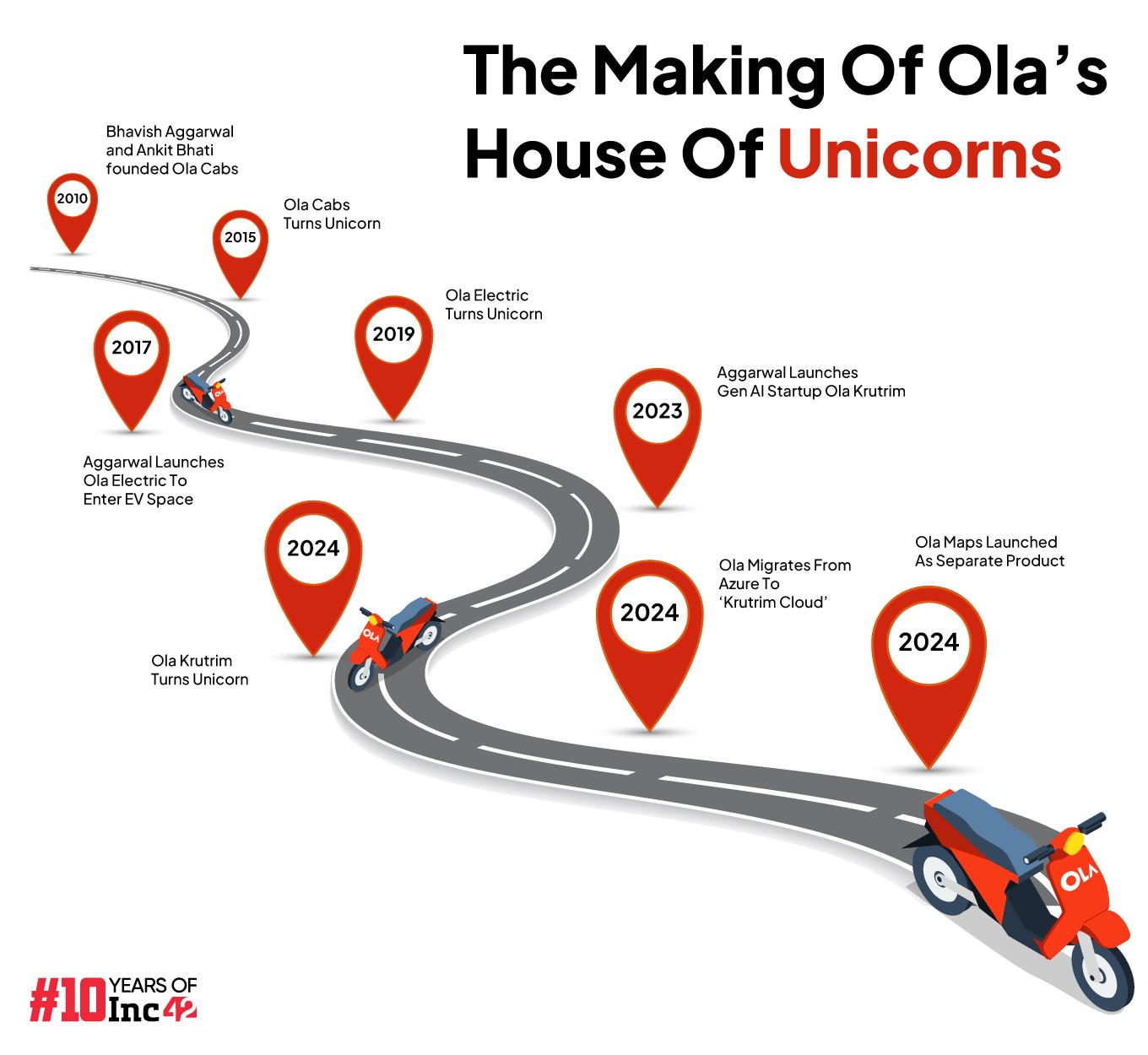

But does Ola Maps even have a shot in this market, where the incumbents have decades of expertise and experience?
Ola Maps Joins India’s Digital Mapping Frenzy
For the past 18 months, Ola Maps has been developed by Ola Cabs’ parent company ANI Technologies, building on the 2021 acquisition of Pune-based startup GeoSpoc.
Unlike Ola Krutrim and Ola Electric, which were independent entities from inception and shared the Ola brand name and the company’s resources, Ola Maps is currently part of Ola Cabs’ parent company ANI Technologies.
This is why there is some speculation about Ola spinning off Ola Maps into a separate entity and offering it to developers and other product startups as an API-based service. Aggarwal on X mentioned that Ola Cabs has been spending around INR 100 Cr on third-party mapping services.
It will be interesting to see how Ola differentiates itself from the host of players that make up the mapping market. Although Google Maps and MapmyIndia are the two most dominant players, there are others such as Apple Maps, Dutch giant HERE Technologies, TomTom, MapBox, OpenStreetMaps among others.
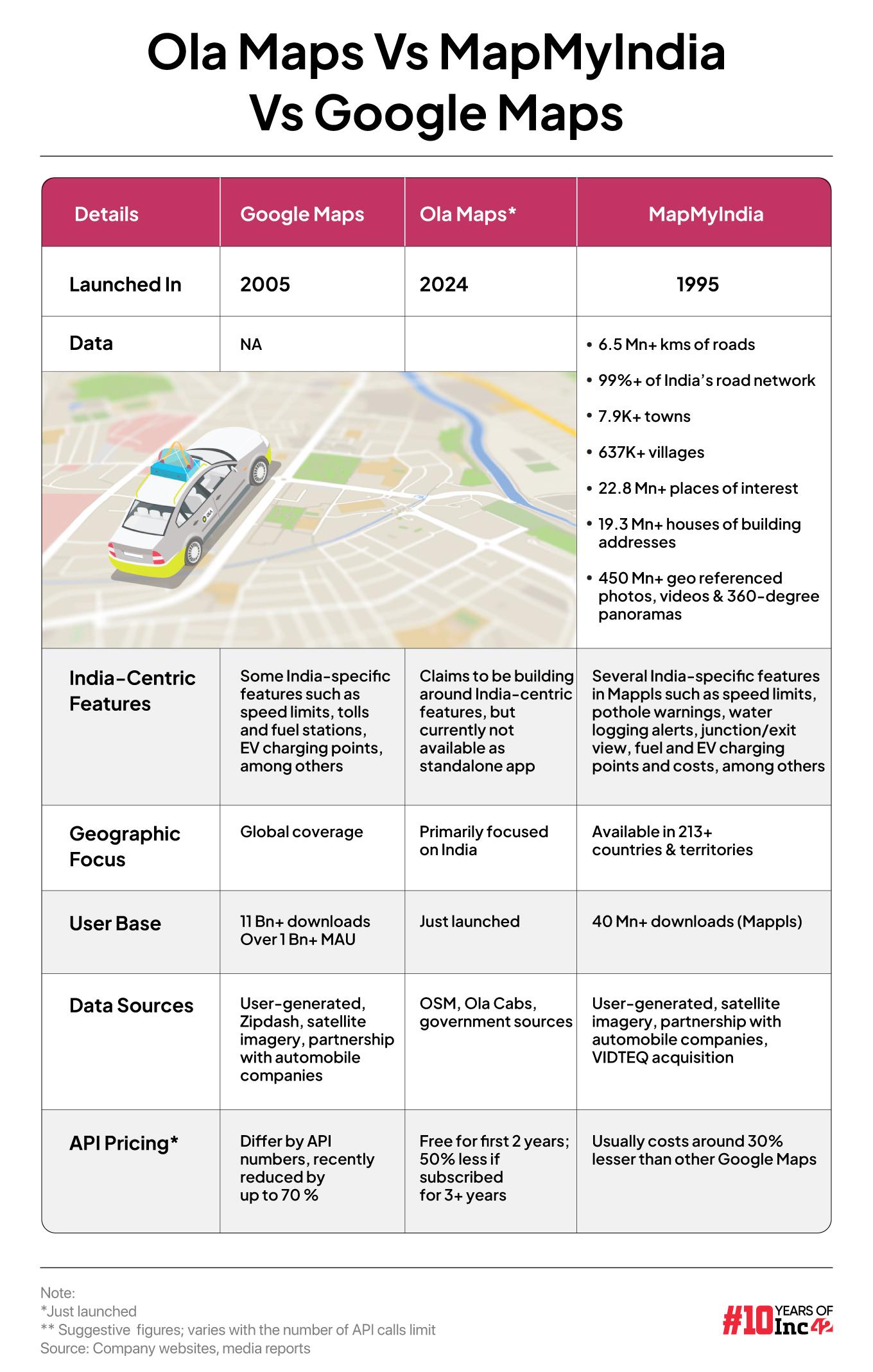

The digital maps and location intelligence services market consists of digital maps services, navigation solutions and telematics for business as well as consumer applications. And most of these companies have products that cater to both B2B and B2C or either of these verticals.
The opportunity in the digital mapping space is very large. For instance, MapmyIndia’s operating revenue nearly doubled in the past two fiscal years from INR 200 Cr in FY22 to INR 379.4 Cr in FY24.
It is hard to estimate how much Google Maps is earning from India, as the tech giant does not disclose numbers for Google Maps nor its business in India. We do know that most service providers that operate at scale rely on Google Maps.
Swiggy and Zomato, for instance, would be contributing significantly to Google Maps revenue in India, given the millions of orders these platforms process daily for food delivery and quick commerce. Uber India too is a major customer for Google Maps, and Google Maps is pre-installed on millions of Android devices.
It is hard to fight dominance of this scale, but MapmyIndia has looked to do that through customer acquisition and leading an antitrust battle with Google Maps, as we have written about in the past.
For context, Google Maps entered the Indian market in 2007, a decade after MapmyIndia’s first product. Last year, MapmyIndia CEO Rohan Verma told Inc42 that MapmyIndia offers a superior product thanks to speed limit indicators, pothole indicators, 3D junction view (for exits and flyovers), several of which are still missing from Google Maps.
However, dethroning Google is no easy task, particularly because of its extensive tech industry network, deep pockets and Android’s dominance in the smartphone market due to which most Android devices come preloaded with Google Maps.
For MapMyIndia and other majors in the space, it’s the B2B market which includes ride-hailing services, automobile, enterprise solutions, and delivery services that’s been the key addressable market.
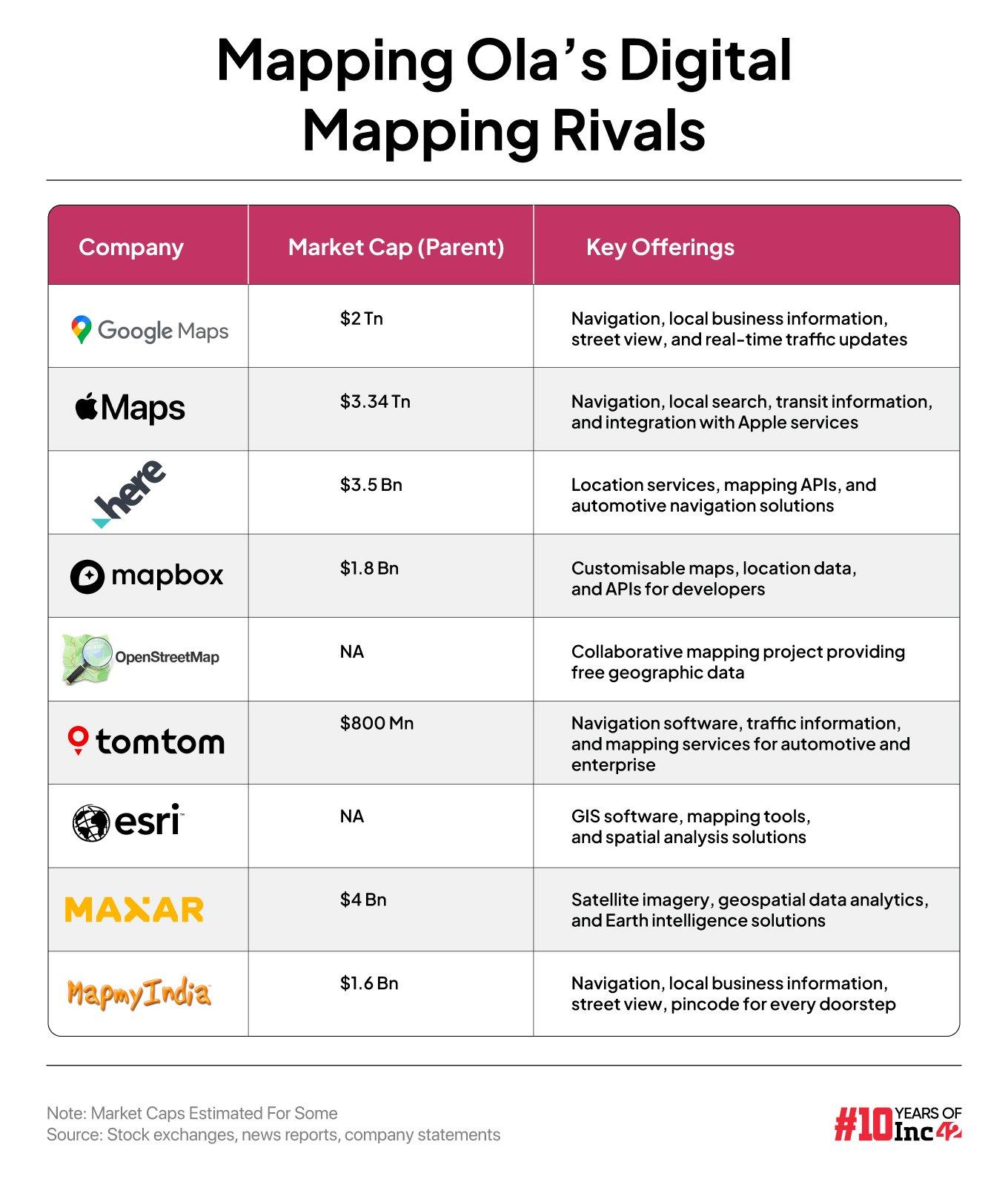

MapMyIndia claims to have captured over 80% of the connected vehicle market, where its apps and devices are installed on-board by the OEM. It also claims to be working with distribution companies, particularly in the food and beverages space.
So the question is where can Ola even compete in such a market, where two large players already have deep roots.
Ola’s Maps Journey From 2021
Ola’s journey into the mapping world began after the Indian government changed the guidelines for geospatial data in early 2021. The guidelines restricted foreign companies to a 1-metre accuracy and mandated the use of APIs for such companies from authorised domestic licensees. No such restrictions are applicable for Indian companies.
The 2021 Guidelines liberalised the entire approach to how an entity could collect the mapping data. Before, it was heavily guarded. And, one needed to have a license and approval from the Indian government to enter the mapping data / streetview data collection.
“This was a major reason why Google could not be directly involved in mapping data collection in India before 2021. Instead, it has had to partner with entities such as Tech Mahindra to collect data for mapping solutions,” a former India-based Google Maps developer told Inc42.
It was in this India-first milieu that Aggarwal set the roadmap for Ola Maps after the GeoSpoc acquisition.
Aggarwal’s thesis was that domestic map solutions are critical to democratise access to digital services for all Indians, especially outside the metros.
He also said that multimodal transportation options such as drones, autonomous vehicles or other new-ge connected vehicles will require more detailed geospatial data, including high-definition and three-dimensional (3D) maps.
In its first Maps blog, Ola claimed that existing maps do not address challenges such as inaccuracy, inconsistency, varying street names, frequent changes in road networks, non-standardised streets, potholes, and road quality issues.
Some of these problems are incidentally also MapmyIndia’s USP as Verma told us in January last year.
But Ola Maps does offer a big upside for Aggarwal and Ola’s many verticals:
- Cutting Costs: The company will no longer have to spend INR 100 Cr on mapping APIs and SDKs
- New Revenue Stream: The in-house mapping solutions is a new revenue stream for Ola
- Data Ownership: Ola Maps allows the company to have complete control over user location data, which feeds into other Ola businesses such as ride-hailing, Ola Electric as well as any other verticals launched by the company, including Ola’s recent push into food delivery with ONDC
Of course, competition is beneficial for the entire ecosystem, since this will create a race to offer more features at better prices.
But building a mapping platform is no easy task. During an interaction with Inc42, a few weeks back, MapmyIndia CEO Verma said, “It is a huge infrastructural task to create a solid foundation of accurate maps based on ground reality for a large country like India (3.2+ Mn sq km to 6.6 Mn sq km!), and then an even more herculean task to maintain and keep the maps updated as the landscape changes.”
According to him, it is very hard to firstly build and maintain maps, and secondly make it into a viable business. “Many players have tried and failed after a few years,” Verma said.
Ola Maps, which first appeared on the company’s EVs and inside Ola Cabs, is now being offered to developers.
For a moment, let’s put aside the controversy around MapmyIndia’s legal notice to Ola and see how the latter claims to have built Ola Maps.
As per the company’s statements, it acquired data from Open Street Maps under a licence agreement, as well and from government sources, while also deploying sensors in some Ola Cabs and across the data operations fleet such as cameras, radar, and LiDAR.
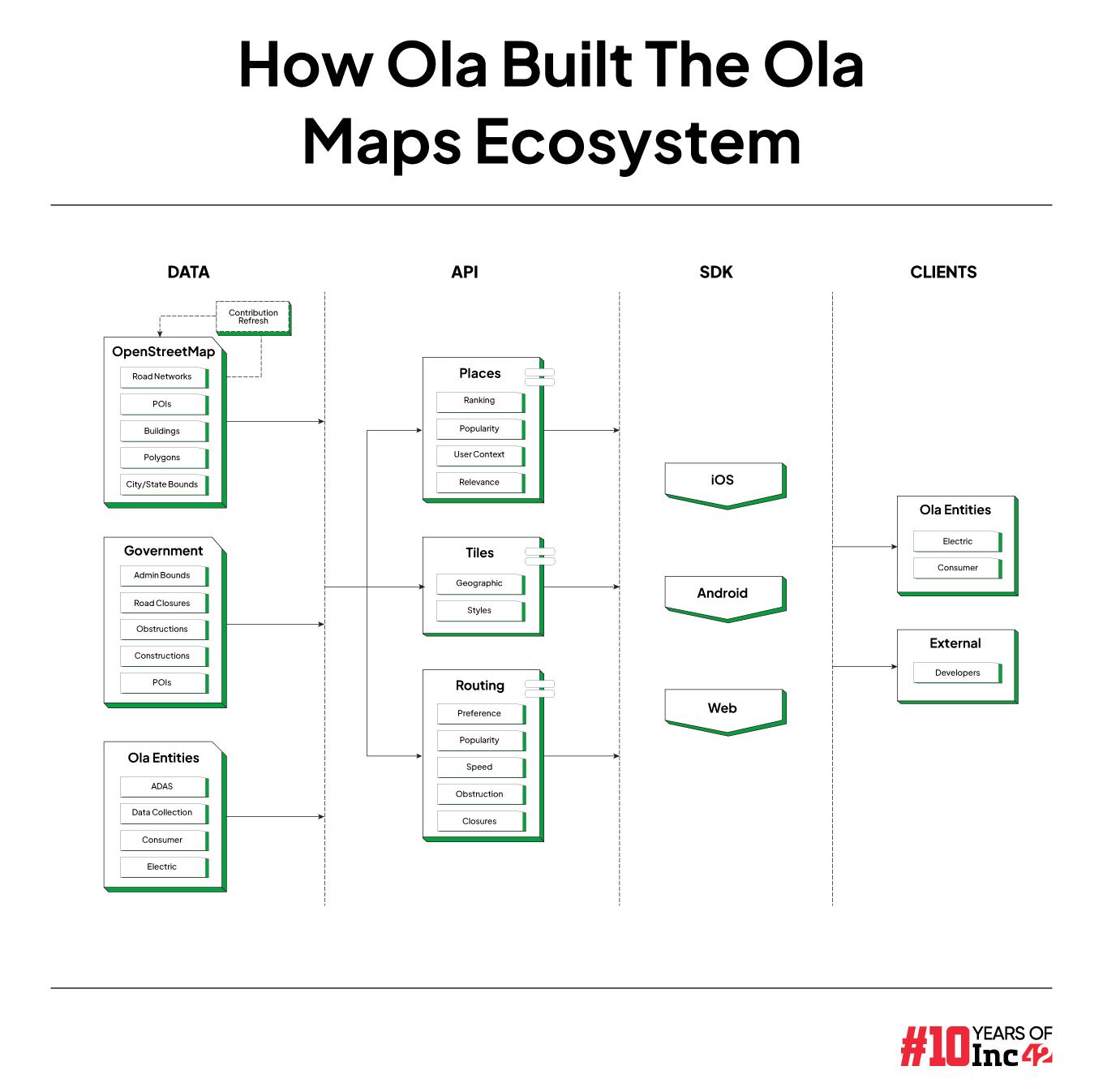

By processing this data, Ola said it developed a suite of APIs and SDKs for B2B use cases. Ola claimed that its maps platform ingested more than 5 Mn messages per second from various sensors and telemetry sources. The petabytes of data is collated, normalised, anonymised, and stored in a data lakehouse. Data streams from various sources are further divided into pipelines to collect relevant data for training AI models, analytics, and data ops for maps.
The final output is stored in map databases for tiles, places, and routes systems. Ola Electric, meanwhile, has shelved its electric project which was unveiled in 2022, so for now, Ola will instead be relying on its EV two-wheelers and its fleet of cabs for further data collection.
Suvonil Chatterjee, the chief technology and product officer of Ola Electric, said in a tweet that AI is at the heart of Ola Maps. The company leverages natural language processing for contextual searches, real-time traffic prediction, dynamic routing algorithms, and automated map updates, Chatterjee said.
What Ola Can Learn From Apple Maps
While the Indian ecosystem has largely applauded the launch, some maps users pointed out bugs and shortcomings such as Ola’s reliance on Google Autocomplete API, routing issues and even about Ola using SDKs from other mapping solutions such as MapBox.
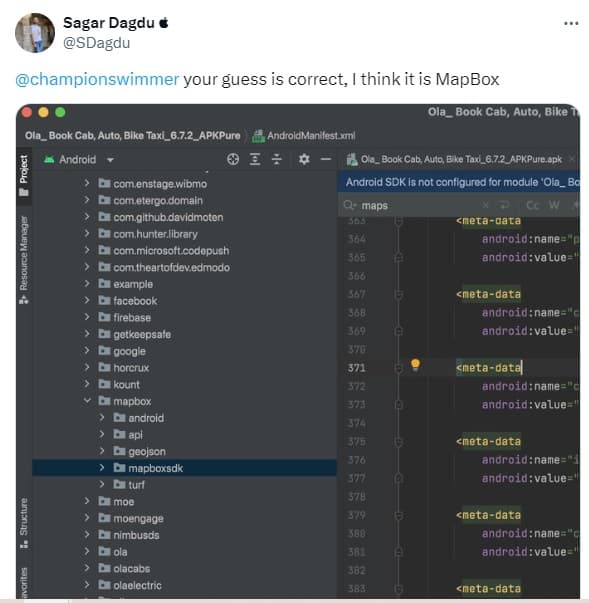

“The APIs offered by Google Maps are simply much more extensive, but the start by Ola Maps is promising. However, with Ola Maps currently being constrained to the Ola ecosystem, most issues are still not public as drivers rarely report them,” according to a founder of location-based services startup.
Moreover, some APIs are difficult to build in terms of accuracy and seamlessness and require multiple datasets to work together. Take for instance, Google Maps’ Places APIs. Industry insiders believe this is especially difficult to develop, because Google relies on high-quality data from Search and other products. This is partly why Google’s Maps APIs are so feature-rich.
In fact, mapping platforms have transformed into super apps / super platforms incorporating a slew of vertical requirements. Users can directly reserve a table using Google Maps or seek appointments with a doctor or make inquiries about what products a nearby kirana store has in stock.
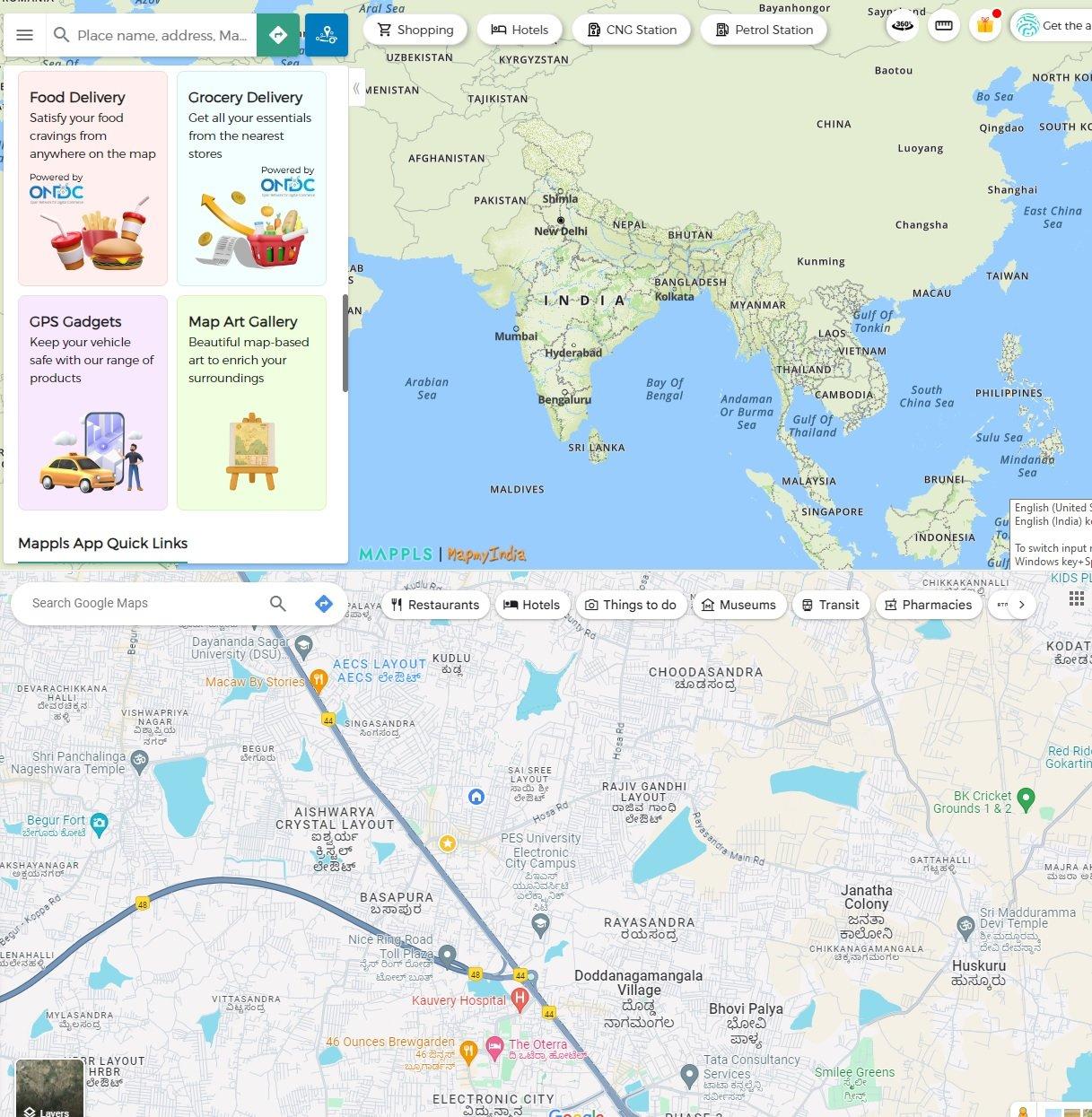

MapmyIndia’s consumer app Mappls has partnered with ONDC to incorporate some of these features and more into its products, and the company has also tied up with wearables maker boAt to introduce some features for smartwatches, a category where devices running Google Maps and Apple Maps are typically more expensive than boAt’s smartwatches.
Apple Maps has also built such features into its APIs but not all of these are available in India. In the US, where Apple is in a much more dominant position, these APIs are more feature-rich.
What these feature-rich mapping solutions tell us is that mapping apps are no longer just about directions or finding the fastest route between two points. Maps apps are moving towards super apps in some ways.
Apple’s example is most apt for Ola. Apple Maps was heavily criticised at launch in 2012 for having poor accuracy and mislabelled information. It took the company more than a decade to come close to Google in terms of service quality and features.
It wasn’t easy for Apple, but having a revenue-generating machine such as the iPhone did help in staying the course. Does Ola have the tenacity that Apple showed?
For Ola to directly take on Google Maps or Apple Maps, it is critical to add some of these consumer-friendly features, since they can have a snowball effect and bring more B2B customers on board as well. For Ola Maps, the arduous task begins now.
Ola Maps might well find itself in the unicorn club if Aggarwal decides to spin it off, but that will still be a valuation game. Dethroning Google, MapmyIndia and even Apple Maps won’t be as simple as going from point A to point B.
[Edited by Nikhil Subramaniam]



![[CITYPNG.COM]White Google Play PlayStore Logo – 1500×1500](https://startupnews.fyi/wp-content/uploads/2025/08/CITYPNG.COMWhite-Google-Play-PlayStore-Logo-1500x1500-1-630x630.png)